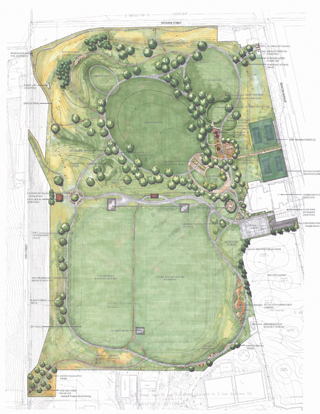|
Subscribe / Renew |
|
|
Contact Us |
|
| ► Subscribe to our Free Weekly Newsletter | |
| home | Welcome, sign in or click here to subscribe. | login |
Architecture & Engineering
| |
June 26, 2008
A park takes shape on Beacon Hill reservoir
Journal Staff Reporter
A 270,000-square-foot cavernous space underground in Beacon Hill will soon be underwater, making room for 26 acres of parkland above.
Crews will finish burying the Beacon Hill Reservoir within the next few weeks and the Seattle parks department expects to go out for bid by December to recreate Jefferson Park, more than doubling its size. Jefferson Park, at 4165 16th Ave. S., follows in the footsteps of Capitol Hill's Cal Anderson Park, which put 3.8 acres of parkland atop the former Lincoln Reservoir when it opened in 2005.
Work is also underway on Myrtle Park atop the Myrtle Park Reservoir at Southwest Myrtle Street and 35th Avenue Southwest. Two more reservoir-park projects are planned: the West Seattle Reservoir and the Maple Leaf Reservoir, with reservoir burying there expected to be completed in 2010 and 2011 respectively.
Seattle Public Utilities is budgeting about $142 million to bury the reservoirs, with money coming from Seattleites' monthly water bills. The projects will add 76 acres of parkland to the city, with most of the money for park development for Cal Anderson, Beacon Hill and Myrtle coming from the 2000 Pro Parks Levy.
Burying reservoirs costs three to four times more than lidding them with floating tops, but Mayor Greg Nickels said it's worth every penny to create more open space.

Security concerns following the terrorist attacks in New York and Washington, D.C., in 2001 got the ball rolling to lid Seattle's open reservoirs. But just capping them with floating lids as was done at the Bitter Lake Reservoir in 2001 looked “hideous,” Nickels said, and required fencing to shut the space off from the rest of the neighborhood.
“I went and took a look at the one at Bitter Lake and I was appalled,” Nickels said. “You get this ugly, hideous thing in the neighborhood.”
Turning them into parks, on the other hand, gives people access to some of the best viewpoints in the city, Nickels said, because reservoirs were built in Seattle's highest points.
In 2002, Nickels proposed replacing the reservoirs with underground concrete structures. Seattle City Council approved the plan in 2004.
Nickels said burying reservoirs also makes sense financially. Buried reservoirs last about 100 years, compared with a 25-year life expectancy for the floating lids. He said he hopes other cities will take up the idea, and said he plans to show before and after images of Beacon Hill Reservoir to the U.S. Conference of Mayors.
Burying Beacon Hill's reservoir will cost about $40 million and creating the park above will run $8 million.
Jefferson Park had little open green space before work began, said Andy Sheffer, senior capital project coordinator with Seattle Parks and Recreation, because fenced reservoir space cut through much of the parkland.
When work is complete, Jefferson Park will have two protected viewpoints, meaning neighboring building will be restricted to prevent obstruction of its panoramic look on downtown. It will also have sports fields, a meadow-like open space, an amphitheater and a kid's play area. It will have rain gardens designed by Elizabeth Conner and a system of pathways modelled after designs done by the Olmstead Brothers.
The park is next to a community center and will have rare “unprogrammed space,” meaning not all of its fields will be earmarked for sports, Sheffer said.
The Berger Partnership is landscape architect.
Parks Superintendent Timothy Gallagher said he knows of no similar reservoir-turned-parks projects elsewhere in the United States. Gallagher, who recently bought a house near Discovery Park, said the parks will improve property values and quality of life for the neighborhoods.
Beacon Hill is the biggest of the reservoir projects, but SPU project manager Stephanie Murphy said the design and construction work has been pretty straightforward. One of the biggest challenges, she said, has been burying Myrtle and Beacon Hill simultaneously.
Murphy said she expects the reservoir will need to be drained and cleaned about once every four or five years, compared to annually with the open reservoirs.
MWH Americas was design engineer for all the reservoir projects. MidMountain Contractors of Kirkland was general contractor on Lincoln and Myrtle, and is the general contractor on Beacon Hill. It is the apparent low bidder for the West Seattle reservoir, according to project superintendent Ken Spiker. Spiker said the company also plans to bid on Maple Leaf.
Spiker said the biggest challenge so far has been the weather, but lots of communication with SPU has kept construction schedules on time.
“They've been really receptive to things,” Spiker said.
Tetra Tech did electrical instrumentation and control, Beyaz & Patel did the mechanical vault structure, R.W. Beck did stormwater and surfacewater management and J.P. Francis & Associates of Kent was mechanical contractor for burying the reservoir.
The Jefferson Park renovation project will go out to bid for a contractor by December, Sheffer said, and he hopes construction will be done within the year. The new park will be “huge” for its neighbors, he said, connecting them with green space and the community center already on the hill.
“A lot of people didn't even know there was a park here because so much of it was fenced off,” he said.
Shawna Gamache can be
reached by email or by phone
at (206) 622-8272.


